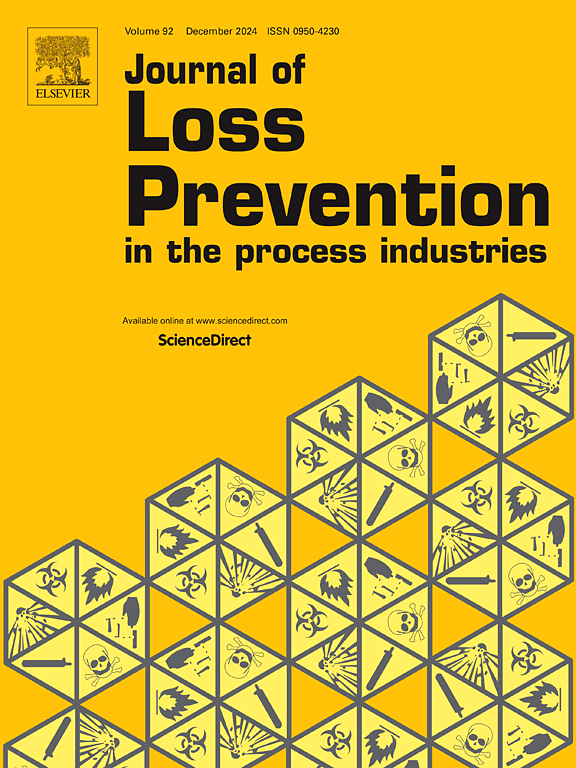加强安全关键要素(sce)分析,以减轻早期生产设施(EPF)中的重大事故危害(MAH):印度尼西亚的案例研究
IF 4.2
3区 工程技术
Q2 ENGINEERING, CHEMICAL
Journal of Loss Prevention in The Process Industries
Pub Date : 2025-06-25
DOI:10.1016/j.jlp.2025.105728
引用次数: 0
摘要
早期生产设施(EPF)是一种临时加工设施,可以以较低的初始成本生产石油,降低财务风险。EPF尽管具有财务优势,但仍面临着与过程安全相关的重大挑战。虽然现有的研究已经解决了EPF的各个方面,包括风险评估、设计和经济可行性,但在EPF运行特定的重大事故危险(MAH)和安全关键要素(SCEs)的识别和分析方面仍然存在重大差距。本研究解决了识别潜在MAH和相应的SCEs以降低EPF重大事故风险的研究问题。该研究的重点是位于印度尼西亚西爪哇的三个(3)地区的EPF: AMJ、BMH和HGD。采用HAZOP和Bowtie方法系统地鉴定所选EPF中潜在MAH和相关sce。本研究确定了EPF的32个MAH情景。72%的事故影响到火灾/爆炸,这对人身安全和设施完整性构成了威胁。EPF上的大多数MAH场景由两个主要原因触发:超压和腐蚀。在分离器、管线和放大器等设备中确定了大部分MAH场景。本研究共鉴定出188种sce。通过对已识别的sce进行优先级排序,维护资源可以集中在直接预防或减轻MAH的关键因素上,从而在不影响安全性的情况下提高成本效益。74%被列为技术/硬件障碍。这突出了一个强大的维护策略的必要性,以保证这些技术元素随着时间的推移的可靠性和有效性。未来的工作还可以集中在通过结合定量风险建模方法来改进当前的Bowtie分析,并制定sce的性能标准,这些标准可用于增强稳健的维护策略。本文章由计算机程序翻译,如有差异,请以英文原文为准。
Enhanced analysis of Safety Critical Elements (SCEs) to mitigate Major Accident Hazards (MAH) in Early Production Facilities (EPF): A case study in Indonesia
Early Production Facilities (EPF) is a temporary processing facility that allow oil production at low initial cost and reduced financial risk. EPF still faces significant challenges related to process safety despite its financial advantages. Although existing studies have addressed various aspects of EPF, including risk assessment, design, and economic feasibility, a significant gap remains in the identification and analysis of Major Accident Hazard (MAH) and Safety Critical Elements (SCEs) specific to EPF operations. This study addresses the research problem of identifying potential MAH and the corresponding SCEs to reduce the risk of major accidents in EPF. The study focused on EPF located in three (3) areas: AMJ, BMH, and HGD which are located in West Java, Indonesia. HAZOP and Bowtie methods were employed to systematically identify potential MAH and relevant SCEs in the selected EPF. 32 MAH scenarios on EPF identified in this study. 72 % of accidents have an impact on fire/explosion, which poses a risk to personal safety and facility integrity. Most MAH scenarios on EPF are triggered by two primary causes: overpressure and corrosion. A major proportion of MAH scenarios are identified in equipment such as Separator, Flowline & Manifold, and Scrubber. 188 SCEs were identified in this study. By prioritizing the identified SCEs, maintenance resources can be focused on critical elements that directly prevent or mitigate MAH, thereby improving cost-effectiveness without compromising safety. 74 % were classified as technical/hardware barriers. This highlights the necessity of a robust maintenance strategy to guarantee the reliability and effectiveness of these technical elements over time. Future efforts could also focus on refining the current Bowtie analysis by incorporating quantitative risk modeling methods and on developing performance standards for SCEs, which can be used to enhance the robust maintenance strategy.
求助全文
通过发布文献求助,成功后即可免费获取论文全文。
去求助
来源期刊
CiteScore
7.20
自引率
14.30%
发文量
226
审稿时长
52 days
期刊介绍:
The broad scope of the journal is process safety. Process safety is defined as the prevention and mitigation of process-related injuries and damage arising from process incidents involving fire, explosion and toxic release. Such undesired events occur in the process industries during the use, storage, manufacture, handling, and transportation of highly hazardous chemicals.

 求助内容:
求助内容: 应助结果提醒方式:
应助结果提醒方式:


